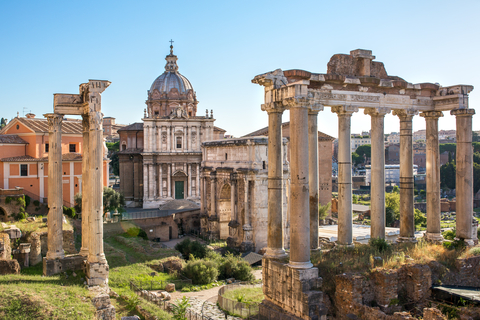Exciting Travel Destinations and Tours – Rome, Italy
Ancient Rome—the center of world commerce for centuries.
Our first Rome main course starts in the center of city life—the Forum.
 Built on marshy land drained into the nearby Tiber River, the Forum was the meeting place for trade, commerce, and eventually became the location for numerous temples devoted to the main Roman Gods. Within easy walking distance, the cattle and vegetable markets (near the Tiber), Marcellus’ Theater, an outdoor amphitheater, the Circus Maximus, the Hippodrome of Domitian, Titus and Trajan’s Baths, and the Colosseum bordered the Forum.
Built on marshy land drained into the nearby Tiber River, the Forum was the meeting place for trade, commerce, and eventually became the location for numerous temples devoted to the main Roman Gods. Within easy walking distance, the cattle and vegetable markets (near the Tiber), Marcellus’ Theater, an outdoor amphitheater, the Circus Maximus, the Hippodrome of Domitian, Titus and Trajan’s Baths, and the Colosseum bordered the Forum.
From around 700 B.C. to 29 A.D., the Forum transitioned from a farming community to world-renowned center of knowledge and civilization. The Emperors, starting about 27 B.C. began the process of building with white marble in the Forum. With blue skies outlining the white stone structures of gargantuan size for the time period, the effect would awe any visiting dignitary, not to mention even today’s spectators.
Today you can walk through Septimius Severus’ Arch to obtain a measure of the buildings that once towered over the crowds. The height of the arch is a little more than 75 feet. The Colosseum in the distance is 157 feet tall.
Right next to the entry you will also find the Curia, a Senate House built in 44 B.C., and the ruins of the Temple of Saturn. The Curia is mostly intact because of its conversion to a consecrated building, Sant’Adriano al Fora, in the seventh century. However, some parts of this building have been modernized.
On the other side of Septimius Severus’ Arch you will find the ruins of the Temple of Saturn, the third oldest temple in Rome after the Temples of Jupiter and Vesta. Not only did the Temple house the statue of Saturn, the Senate used the space as its treasury. Eight columns of the Temple remain, standing many feet taller than the Arch. It’s fascinating to wander through these marble pillars recalling the bustling days of the Roman empire.
Numerous ruins and temples exist in the Forum. At the opposite end, another arch rises—the Arch of Titus. The Via Sacra, or Sacred Way, contains well-preserved remains of a Roman road paralleling the road traveling through Septimius Severus’ Arch. The Temples or Romulus, Julius Caesar, Venus and Rome, and Castor and Pollux can be seen, some in complete ruins, others in semi-preserved states.
Let the history of Rome seep into your system by spending adequate time to take in the setting of Roman formal celebrations and parades, Roman government and political decision-making, and the center of social life for this ancient culture.
Next month? The Colosseum. Don’t miss it. And check out this website for more: http://www.italyguides.it/en/lazio/rome/travel-guides/travel-tips/rome-in-a-nutshell






